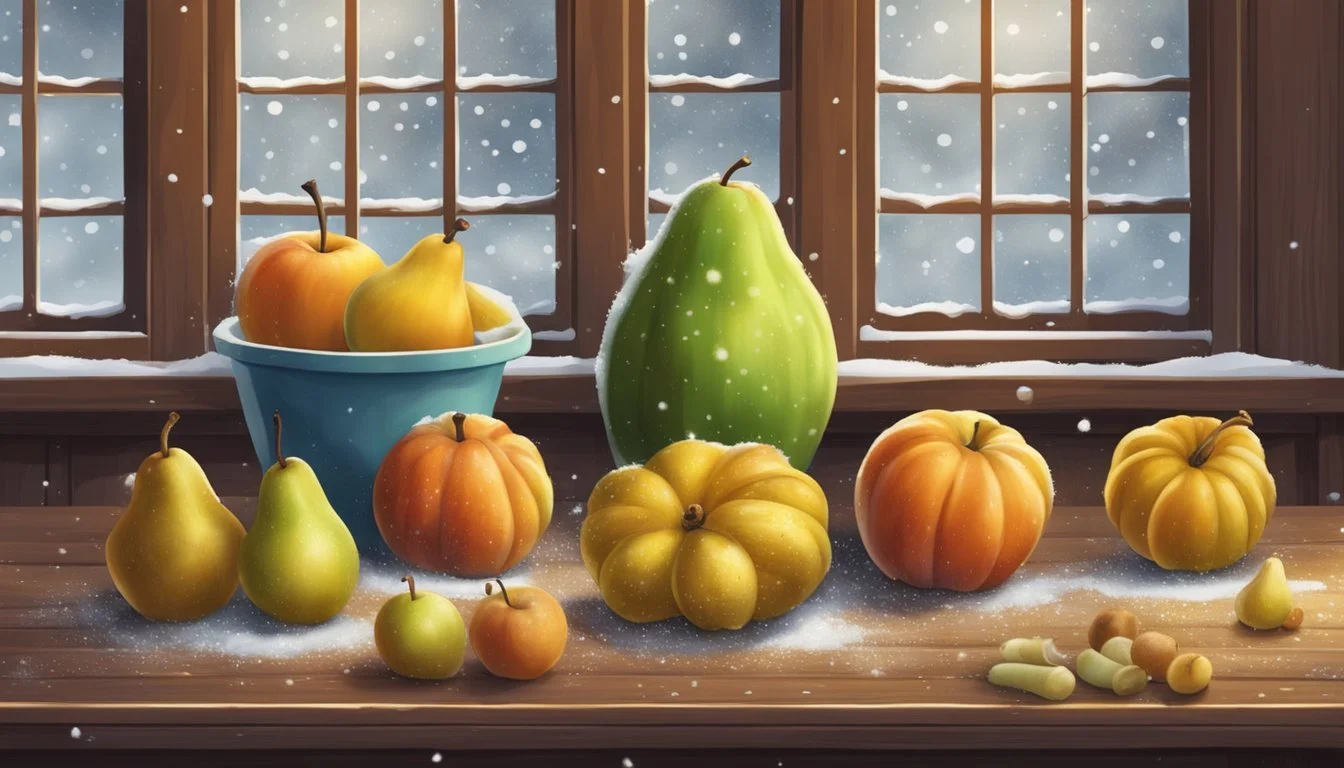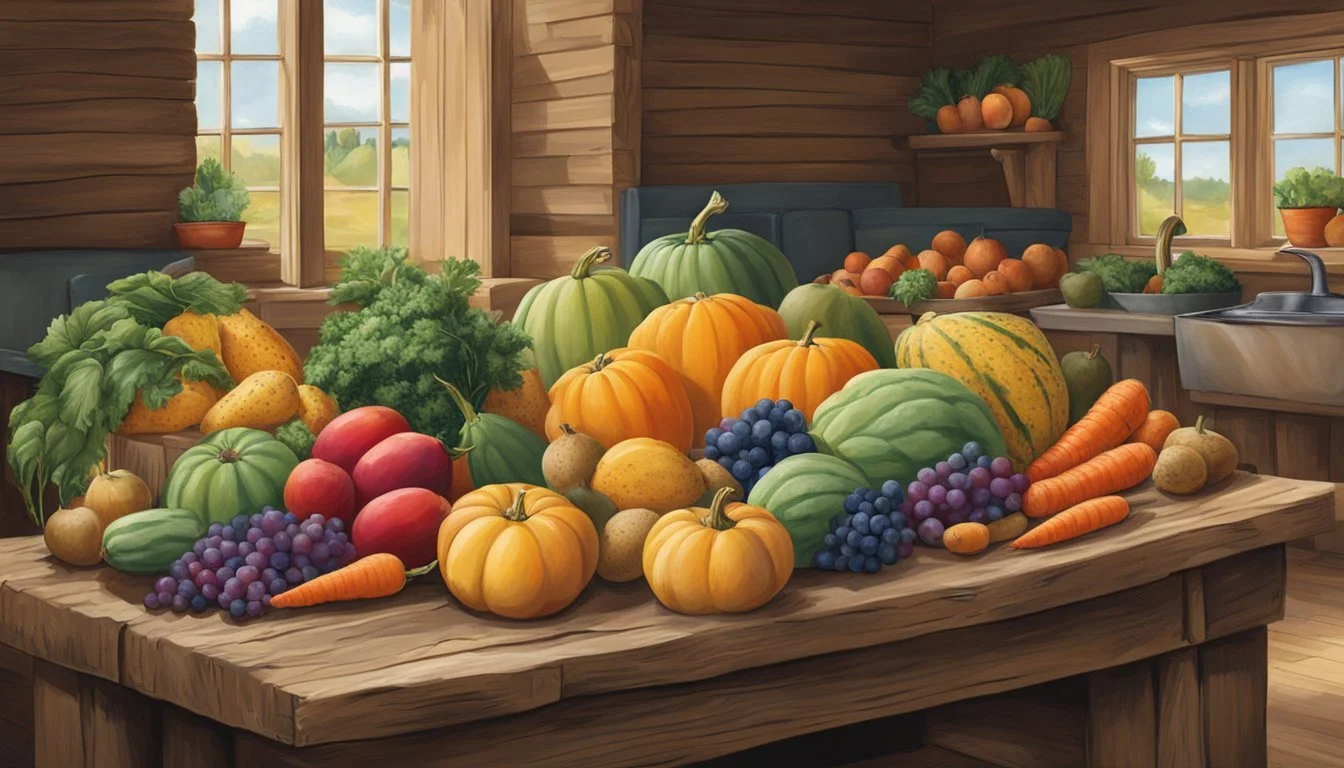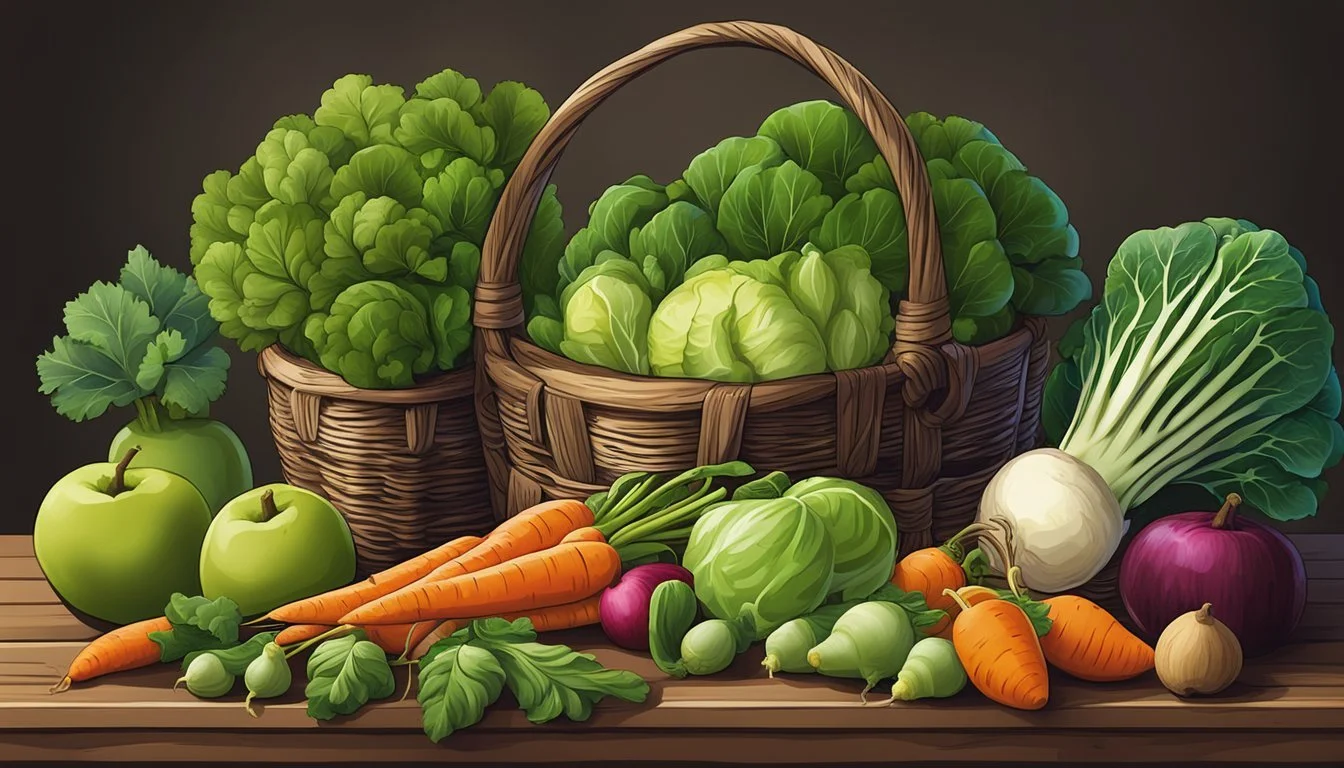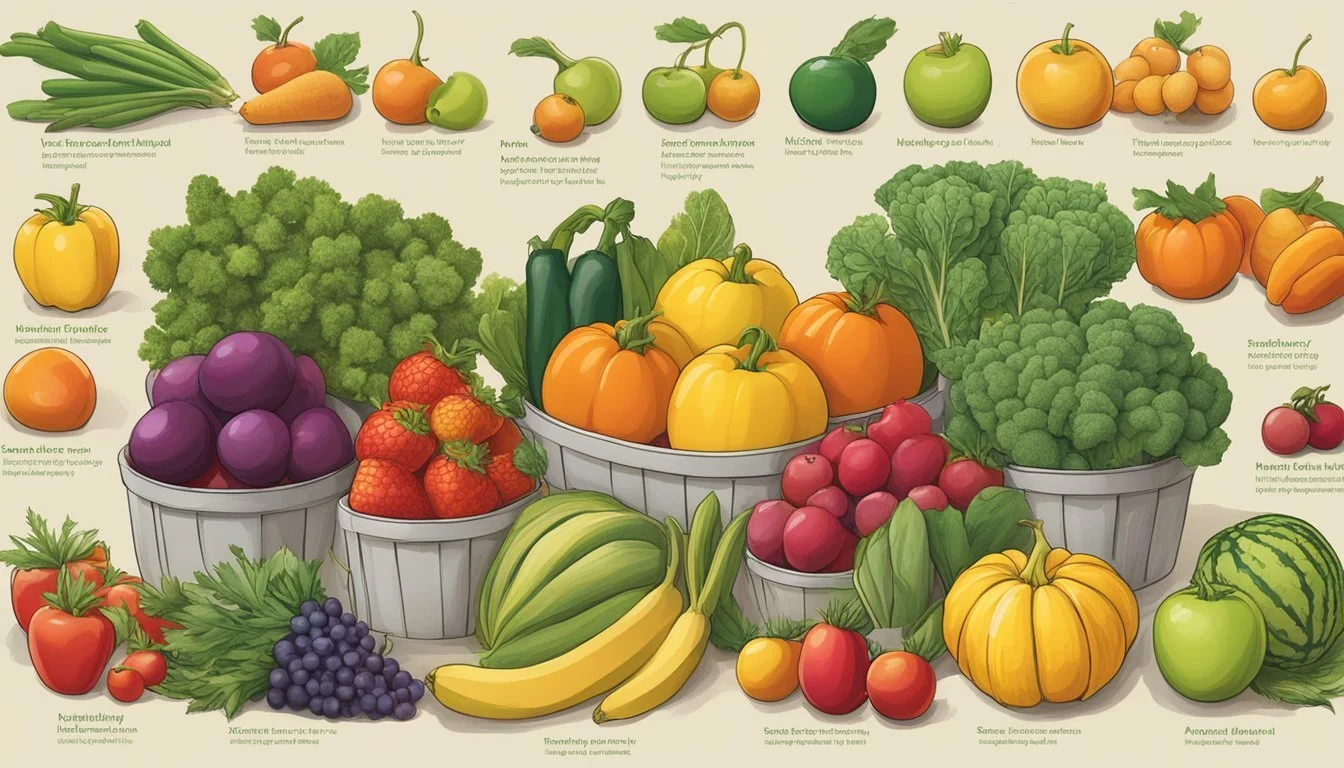Nebraska Seasonal Fruit & Vegetables in December
Your Guide to Fresh Produce
This Article is Part of our Nebraska Seasonal Fruit & Veg Calendar
In the midst of a brisk Nebraska December, while the landscape is often blanketed in snow, local produce continues to offer its bounty to discerning consumers. Despite the cold, winter does not signal a halt in the availability of fresh fruits (What wine goes well with fruit?) and vegetables in the state. Seasonal eating in Nebraska during this time relies heavily on storage crops and greenhouse-grown produce.
Residents look to root vegetables such as potatoes, onions, and carrots (how long do carrots last?), which are not only staples but also enjoy a natural resilience, allowing them to be stored and used throughout the winter months. Winter squashes, with their thick skins and dense flesh, are treasures harvested in the fall and consumed well into the winter season, offering both nutrition and variety.
Beyond these, while fruit options may be more limited, supermarkets and local markets may still carry varieties of apples (how long do apples last?) that are harvested earlier in the fall and kept fresh in storage. These apples, such as Early Gold, Lodi, and Honey Crisp, maintain their quality and offer sweet and tart flavors perfect for winter desserts and dishes. The emphasis on seasonality ensures that even in December, the produce consumed is at its freshest, aligning with a farm-to-table approach that supports the local economy and provides Nebraskans with nourishing food options.
Seasonality of Produce in Nebraska
In Nebraska, the availability and variety of seasonal produce shift with changes in climate and growing conditions. During December, residents often turn to crops that store well from previous harvests or that can withstand colder temperatures.
Understanding The Growing Season
The primary growing season in Nebraska often ends as winter approaches, but the agricultural sector adapts through the cultivation of winter-hardy varieties and the use of storage for crops harvested earlier in the year. Winter squash is an example of a vegetable that, due to its hardy nature and good storage qualities, remains available during the winter months. It's important to note that while the fresh produce selection may dwindle in December, the food system in Nebraska ensures a supply of robust, seasonal items.
Winter Squash Varieties: Acorn, Butternut, Spaghetti
Winter's Impact on Crops
As winter sets in, Nebraska's agriculture feels the brunt of the cold, impacting what can be grown and harvested during this time. Nonetheless, producers prepare for the holiday season by ensuring a selection of produce characteristic of the winter months, including items stored from the fall harvest. The seasonal produce calendar reflects this shift, highlighting the freshest options available, such as root vegetables, which tend to have lasting freshness when stored properly.
December Seasonal Produce:
Root Vegetables: Carrots, Beets, Turnips
Stored Apples: Golden Delicious, Honey Crisp
These crops and storage practices exemplify the rural state's resilience in maintaining a diverse array of produce during colder seasons.
December Fruit Varieties
December in Nebraska showcases a variety of fruits that, even during the colder days, can add freshness and flavor to the dining table. The selection and care for these fruits are integral to maintaining their quality from purchase to consumption.
Selecting the Best Fruit
When choosing seasonal fruits in December, one should look for apples and pears that are firm to the touch and free from bruises or blemishes. The skin of the fruit should be vibrant and indicative of its ripeness. Apples come in several varieties with flavors ranging from tart to sweet; Envy™ apples are known for their sweetness and are a seasonal highlight. Pears, similarly, should have a slight softness at their stem end, signaling they are ripe and ready to eat.
Fruit Storage and Care
Once selected, proper storage is essential to prolong the lifespan of these fruits. Apples prefer a cool, dark place and can be kept for up to four months when stored properly. They are best kept in the refrigerator in a crisper drawer away from vegetables, as apples can speed up the ripening of other produce. Pears, on the other hand, ripen at room temperature. Once they reach the preferred ripeness, they can be transferred to the refrigerator to slow down further ripening.
To retain the maximum flavor and freshness, both apples and pears should be handled with care, avoiding stacking them high as pressure can cause bruising. Additionally, these fruits should be washed just before consumption to remove any residue or bacteria and to ensure the best possible taste and safety.
December Vegetable Options
As the winter chill sets in, Nebraska's vegetable selection in December embraces hearty, robust varieties excellent for nutritious meals.
Popular Vegetables to Eat in December
In Nebraska during December, individuals can enjoy a range of vegetables that thrive in colder weather. Here is a list of some of the most popular vegetables available:
Kale: Hearty and nutritious, kale can withstand cold temperatures, making it an excellent choice for winter salads and soups.
Brussels Sprouts (how long do brussels sprouts last?): These are at their peak in flavor when harvested after the first frost.
Cabbage: A versatile vegetable, cabbage can be used in stews, soups, and fermented foods like sauerkraut.
Root Vegetables: A variety of root vegetables are available, such as:
Carrots: Sweet and crunchy, perfect for roasting or adding to stews.
Radishes: Offer a peppery kick to salads and are also good for pickling.
Onions: A fundamental ingredient, onions add depth to a multitude of dishes.
Sweet Potatoes: Rich in flavor and nutrients, they are ideal for baking or making hearty soups.
Turnips: Can be mashed or roasted for a nutritious side dish.
Parsnips: Their sweet, nutty flavor enhances when roasted or used in soups.
Rutabagas: Another robust root vegetable, great mashed or roasted.
Other vegetables such as fennel (how long does fennel last?) with its distinctive anise-like flavor, Belgian endive, and chard are also suitable December choices in Nebraska.
Vegetable Preservation Techniques
To extend the enjoyment of December's harvest, various preservation techniques can be applied:
Roasting and Freezing: Vegetables like Brussels sprouts, sweet potatoes, and carrots can be roasted and then frozen for future use.
Pickling: Radishes, turnips, and even cabbage can be pickled, providing a flavorful condiment or snack for months.
Canning: A traditional way to preserve vegetables such as cabbage and carrots in the form of relishes or stews.
Cellaring: Potatoes, onions, and other root vegetables can be stored in a cool, dark place to prolong their shelf life.
Fermentation: Cabbage transformed into sauerkraut or kimchi can last for an extended period and is beneficial for gut health.
By using these preservation methods, one can make the most of December's vegetable bounty well into the winter months.
Recipes and Preparation
In Nebraska, December invites a plethora of seasonal produce into the kitchen. Hearty root vegetables and hardy greens take center stage, providing ample opportunities for rich soups and festive holiday dishes.
Holiday Recipes with Seasonal Produce
For holiday gatherings, one can capitalize on the natural sweetness of root vegetables such as beets, carrots, and parsnips. They might prepare a Honey-Roasted Root Vegetables dish that features these ingredients caramelized to perfection – a simple yet elegant side that complements the richness of traditional holiday meats. Another festive option is Citrus-Glazed Rutabaga, reflecting the availability of citrus and balancing the rutabaga's earthiness with a hint of sweetness and acidity.
Everyday Meals with Winter Vegetables
Beyond the holiday table, these seasonal offerings provide nutritional benefits and warmth to everyday meals. Soups, such as a robust Carrot and Parsnip Soup, are simple to prepare and offer comforting nourishment on cold December days. They could also incorporate roasted Brussels sprouts into a fulfilling salad with cranberries or mix boiled turnips into mashed potatoes for a twist on a classic side, adding depth and nutrients. For a quick, healthy option, they might enjoy raw vegetables like radishes or kale as part of a crunchy winter salad or slaw, bringing fresh textures and flavors to the winter palate.
Where to Find Local Produce
In December, Nebraska's local produce can be predominantly found at farmers markets and farm-to-table stores across the state. These venues provide access to seasonal vegetables and fruits, often sourced directly from local farmers and growers.
Nebraska Farmers Markets
Farmers markets in Nebraska serve as a hub for local farms to offer their winter crops and stored autumn produce. Although many markets wind down by late fall, there are still various markets that operate with the help of season-extending techniques such as hoophouses. These structures allow for the growth of hearty vegetables beyond the traditional growing season.
Omaha: The Aksarben Village Farmers Market is a notable spot, operating until mid-October.
Lincoln: Several local markets may have limited operations in December, often supported by community interest and local demand.
Farm-to-Table Stores
Farm-to-table stores in Nebraska bolster the local economy and create a link between consumers and the source of their food. Shopping at these establishments ensures support for local farmers and offers insight into where and how the food is produced.
Local Stores: They typically stock a variety of seasonal produce, with an emphasis on the transparency of the food's origin.
Direct Purchase: Some local farms offer the possibility to buy meat such as turkey, beef, pork, and chicken directly, especially after the processing which occurs in the fall or winter seasons.
Sustainable Practices and Benefits
Adopting sustainable practices when growing and consuming fruit and vegetables in December yields significant benefits for both the environment and the local agriculture sector in Nebraska.
Environmental Impact of Seasonal Eating
Eating seasonally aligns with the natural growing cycles and reduces the environmental footprint of food production. Sustainable agriculture practices in Nebraska during cold months may include using deep winter greenhouses or hotbeds that are heated by organic material. Such methods diminish reliance on fossil fuels for heating and capitalize on the decomposition process as a natural heat source. Seasonal eating in December often involves storage crops and preserved foods, which limits the energy required for transportation and storage, thus reducing greenhouse gas emissions.
Supporting Local Agriculture
Choosing to eat seasonally aids in supporting local farms by ensuring a predictable demand for their produce. By focusing on seasonal produce, consumers contribute to the stability of local farms and help to sustain the local economy. In December, Nebraska farms may offer goods like winter squash and root vegetables. Purchasing these local foods directly helps local Nebraska farms, cultivates community ties, and encourages continued sustainable planting practices and agriculture methods.
Community engagement through purchasing seasonal items propels the adoption of environmentally conscious methods and reinforces the link between agriculture, environment, and seasonal bounty.







